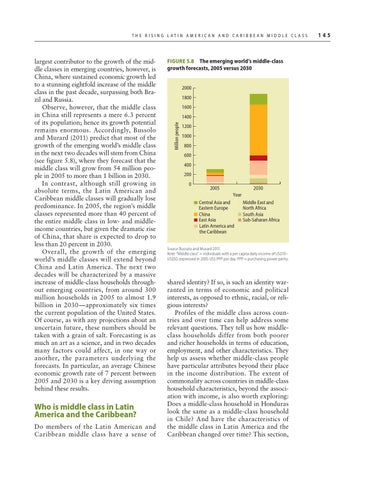THE RISING LATIN AMERICAN AND CARIBBEAN MIDDLE CLASS
Who is middle class in Latin America and the Caribbean? Do members of the Latin American and Caribbean middle class have a sense of
FIGURE 5.8 The emerging world’s middle-class growth forecasts, 2005 versus 2030
2000 1800 1600 1400 Million people
largest contributor to the growth of the middle classes in emerging countries, however, is China, where sustained economic growth led to a stunning eightfold increase of the middle class in the past decade, surpassing both Brazil and Russia. Observe, however, that the middle class in China still represents a mere 6.3 percent of its population; hence its growth potential remains enormous. Accordingly, Bussolo and Murard (2011) predict that most of the growth of the emerging world’s middle class in the next two decades will stem from China (see figure 5.8), where they forecast that the middle class will grow from 54 million people in 2005 to more than 1 billion in 2030. In contrast, although still growing in absolute terms, the Latin American and Caribbean middle classes will gradually lose predominance. In 2005, the region’s middle classes represented more than 40 percent of the entire middle class in low- and middleincome countries, but given the dramatic rise of China, that share is expected to drop to less than 20 percent in 2030. Overall, the growth of the emerging world’s middle classes will extend beyond China and Latin America. The next two decades will be characterized by a massive increase of middle-class households throughout emerging countries, from around 300 million households in 2005 to almost 1.9 billion in 2030—approximately six times the current population of the United States. Of course, as with any projections about an uncertain future, these numbers should be taken with a grain of salt. Forecasting is as much an art as a science, and in two decades many factors could affect, in one way or another, the parameters underlying the forecasts. In particular, an average Chinese economic growth rate of 7 percent between 2005 and 2030 is a key driving assumption behind these results.
1200 1000 800 600 400 200 0
2005
2030 Year
Central Asia and Eastern Europe China East Asia Latin America and the Caribbean
Middle East and North Africa South Asia Sub-Saharan Africa
Source: Bussolo and Murard 2011. Note: “Middle class” = individuals with a per capita daily income of US$10– US$50, expressed in 2005 US$ PPP per day. PPP = purchasing power parity.
shared identity? If so, is such an identity warranted in terms of economic and political interests, as opposed to ethnic, racial, or religious interests? Profiles of the middle class across countries and over time can help address some relevant questions. They tell us how middleclass households differ from both poorer and richer households in terms of education, employment, and other characteristics. They help us assess whether middle-class people have particular attributes beyond their place in the income distribution. The extent of commonality across countries in middle-class household characteristics, beyond the association with income, is also worth exploring: Does a middle-class household in Honduras look the same as a middle-class household in Chile? And have the characteristics of the middle class in Latin America and the Caribbean changed over time? This section,
145
